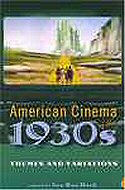|
American Cinema of the 1930s: Themes and Variations
|
|
Edited by: Ina Rae Hark
|

|

Probably no decade saw as many changes in the Hollywood film industry and its product as the 1930s did. At the beginning of the decade, the industry was still struggling with the transition to talking pictures. Gangster films and naughty comedies starring Mae West were popular in urban areas, but aroused threats of censorship in the heartland. Whether the film business could survive the economic effects of the Crash was up in the air. By 1939, popularly called “Hollywood’s Greatest Year,” films like Gone with the Wind and The Wizard of Oz used both color and sound to spectacular effect, and remain American icons today. The “mature oligopoly” that was the studio system had not only weathered the Depression and become part of mainstream culture through the establishment and enforcement of the Production Code, it was a well-oiled, vertically integrated industrial powerhouse.
The ten original essays in American Cinema of the 1930s focus on sixty diverse films of the decade, including Animal Crackers, Dracula, The Public Enemy, Trouble in Paradise, 42nd Street, King Kong, Imitation of Life, It Happened One Night, Mutiny on the Bounty, The Adventures of Robin Hood, Swing Time, Nothing Sacred, Jezebel, Mr. Smith Goes to Washington, and Stagecoach.
Ina Rae Hark is a Professor of English and Film Studies at the University of South Carolina. She has edited or co-edited Screening the Male (1993), The Road Movie Book (1997), and Exhibition, the Film Reader (2001). Among her forty articles and book chapters are studies of The Adventures of Robin Hood starring Errol Flynn, MGM's The Wizard of Oz and Alfred Hitchcock's British Films of the 1930s.
|
|
